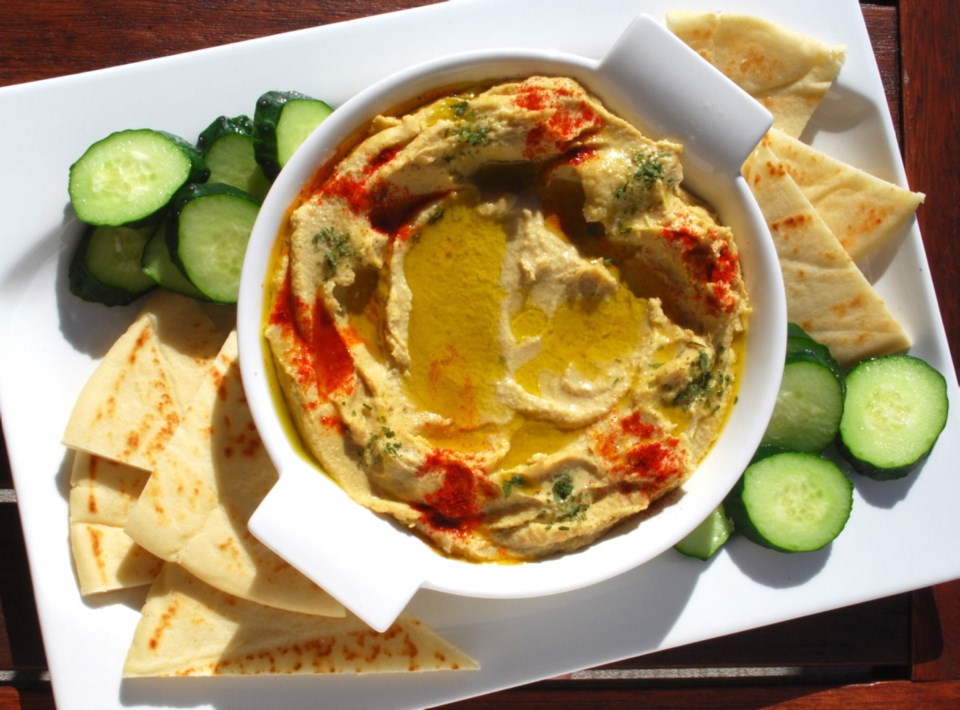 Dear Eric: What is your recipe for a memorable hummus? Jay Rangel
Dear Eric: What is your recipe for a memorable hummus? Jay Rangel
Dear Jay: Hummus is a thick, Middle Eastern-style sauce/spread enjoyed around the world. Hummus is the Arabic word for chickpea. When cooked, it becomes the key ingredient in this mixture flavoured with such things as tahini, garlic, olive oil and lemon.
I’ve previously published recipes for hummus and have not fussed a whole lot with the method. In other words, I used canned chickpeas and put them and all the other ingredients in a food processor, blended them, spooned the hummus into a bowl, and it was good to go.
That style of hummus is perfectly fine, not to mention delicious. But Jay was looking for a recipe for a memorable hummus and to me that means one that is silky smooth, making it a delight on the palate.
A few sources suggested that to get that texture you first had to mix the tahini and flavourings together before blending in the chickpeas. But I didn’t notice any difference in the texture of my hummus when I did that.
To reach the ultra-smooth pinnacle, others said you must remove the skins from the cooked chickpeas before blending. I tried that and you do end up with an ultra-smooth hummus. The problem was that, although the skins come off fairly easily, chickpeas are small and peeling each one was time consuming.
So I went on to try a third suggested method for getting your hummus silky smooth. And that was to simply blend the cooked chickpeas when they were hot and their skins were softer and more conducive to being pureed. It does work and that makes sense because the skin on a cooled, cooked chickpea firms up a bit and consequently will cause your hummus to have a more grainy texture if you blended them in that state.
To make hummus this way, you can soak and cook dried chickpeas until tender and then blend them when hot with the other ingredients.
You can also heat up canned chickpeas with a bit of the liquid they were canned with, before blending them into hummus. In my recipe for Jay, I opted to use dried chickpeas.
Before cooking those chickpeas, I noticed that in some cookbooks, particular those that specialized in Middle Eastern recipes, such as the best-selling Plenty: Vibrant Recipes from London’s Ottolenghi, that baking soda was added to the cooking water because it helps the chickpeas become super-soft when they are cooked, which in turn will make your hummus even smoother when blended.
However, Pulse sa���ʴ�ý, an organization that helps market Canadian-grown lentils, peas, chickpeas and other pulses, says adding baking soda is not recommended as it destroys the thiamin (vitamin B) content.
Despite that, rationalizing missing my thiamin on one occasion would not hurt me, I decided to add some anyway as it really does help make your hummus silky smooth and memorable.
Just to remind you, dried pulses such as chickpeas need to be soaked in cold water for several hours to rehydrate them before cooking. Once you’ve done that, Pulse sa���ʴ�ý says to discard the soaking water, place them in a strainer or sieve, and rinse well under cold running water. Doing this, they say, will wash away any carbohydrates responsible for flatulence and, I’m guessing, make for a happier home.
��
Hummus
Serve this smooth and memorable hummus with wedges of warm pita bread for spreading it on and, if desired, raw vegetables to dunk into it.
Preparation time: 20 minutes, plus overnight soaking time
Cooking time: About 45 to 60minutes
Makes: About 21Ú2 cups
��
1 cup dried chickpeas (see Note)
1 tsp baking soda
1Ú2 cup tahini (see Note)
2 Tbsp freshly-squeezed lemon juice, or to taste
2 large garlic cloves, sliced
2 tsp ground cumin
• pinch ground cayenne pepper
1 tsp salt, or to taste
3 Tbsp extra virgin olive oil
• extra virgin olive oil and lemon juice for drizzling
• chopped parsley and paprika for sprinkling, to taste
��
Place the chickpeas in a bowl and cover with 4 cups of cold water. Soak chickpeas at room temperature for 12 hours, or overnight.
Drain the chickpeas through a sieve.
Rinse well, and then place in a tall, not overly wide pot. Pour in 12 cups of fresh cold water and mix in the baking soda.
Bring the chickpeas to a boil over high heat, and then reduce the temperature until the water is just simmering. Simmer the chickpeas until very tender, 45 to 60 minutes, or a little longer, if needed be.
Drain the cooked chickpeas and reserve 1Ú2 cup of their cooking liquid.
Place the tahini, lemon juice, garlic, cumin, cayenne, salt and 3 Tbsp of the oil in a food processor. Pulse until well combined, and then added the hot, cooked chickpeas. Puree the chickpeas for two to three minutes, or until very smooth. If you find the texture of the hummus to be fine, simply discard the cooking liquid you reserved. If you find the hummus too thick, add some of the reserved cooking liquid and thin until you get the desired texture.
Taste the hummus and add more salt, if needed. Spoon and spread the hummus into a shallow serving bowl (or two of them depending on size), building up the sides a little.
You can serve the hummus warm or cool to room temperature, cover and refrigerate until ready to serve cold or at room temperature.
When ready to serve, drizzle the top of the hummus with a little olive oil and lemon juice. Sprinkle the sides of the hummus with a little chopped parsley and paprika and enjoy.
��
Note: Dried chickpeas are sold in the bulk-foods section of many supermarkets and health food stores, and at stores that specialize in bulk foods. Tahini is a sesame paste sold in jars at most supermarkets and Mediterranean or Middle Eastern food stores. Make sure it is blended well before measuring it for this recipe.
Eric Akis is the author of the hardcover book Everyone Can Cook Everything. His columns appear in the Life section Wednesday and Sunday.



